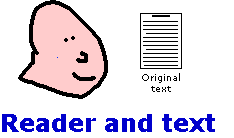Signalling
structure in hypertext:
support for the non-native reader
Background
I Text and the non-native reader
Models of reading
The non-native reader
Structures of text
Structures of knowledge
II Hypertext NN reader support
Strategies for NN reader support
Training in text patterns/cues
Training in knowledge structures
Signalling structure in documents
Examples of signal design
A writing structure curriculum
Extension
Sources
App.
1 An unfolding signal curriculum
Lawrie
Hunter
lawrie@info.kochi-tech.ac.jp
Signalling structure in hypertext:
support for the non-native reader
Non-native readers read differently from first language (L1) readers. NN readers pay more attention to low-level processes such as word identification, whereas L1 readers use much of their attention for higher level processes such as generation of inferences and general knowledge associations (Chun and Plass, 1997). This points to a need to support the NN reader in identifying the structure and background knowledge references in text.
Many of the long-standing techniques for signalling text structure in continuous text documents such as books are not appropriate for hypertext documents such as world wide web (www) pages. As a result, text structure in web pages is relatively difficult to identify. This increases the load placed upon the reader, in particular the non-native (NN) reader of the language in which the document is written.
This paper identifies text structure issues relating to accessibility of text and proposes a comprehensive strategy for supporting the NN reader's reading for structure. It is important to note that this paper takes one theoretical view and one teaching methodology and applies them to one learner case. Without data studies, generalization is not possible.
